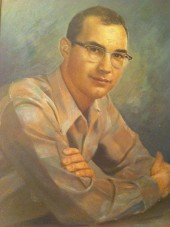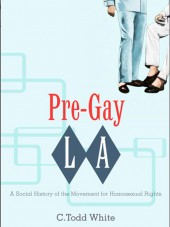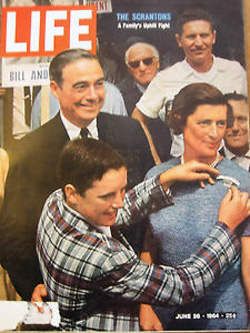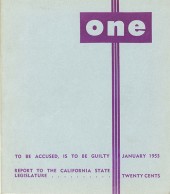 March 14, 2011.
March 14, 2011.
The first point to make is that no one else talking about the subject knew Don Slater or ONE, Inc., in the days before the division in 1965.
Some came after and only talked to Dorr Legg and his co-workers or Jim Kepner, who took Dorr’s side/view even though he had quit ONE twice over Dorr’s deceitfulness, which is why Don Slater acted as he did. (I became a staff member to replace Jim when he quit the second time.) As far as I know, there are only three people still living that were at ONE at the time of the separation. Tony Reyes and Melvin Cain are no longer active. And that leaves me.
I have no ego to protect, but have a moral duty to see that the facts are on the record. Apparently either most people did not read C. Todd White’s book on the subject (Pre-Gay L.A.) or refuse to accept facts that don’t support their agenda.

Many historians and journalists who have written or spoken on this subject have been incompetent and unethical since they never heard our side of the history. That includes an editor of a West Hollywood newspaper who calls our archives a “rump” part of ONE.
And it includes those who only listen to the lies of those who now have what remains of Dorr Legg’s (and Jim Kepner’s) part of ONE, especially John O’Brien, who keeps saying we “stole” Dorr’s library and he “saved” it later, in 1997, when Don died. You have to wonder about the person who will ignore legal documents and listen to the version of history by someone who was not there and has a personal agenda to promote.
The most outrageous claim is that Don Slater, and even Dorr and others at ONE, were not “gay” enough, and were not “out” enough. That is hard to say of course when you consider the facts—they were the first public voice of this movement. Not many people had their picture in a major magazine, LIFE, in 1964, as editor of a homosexual publication, as Don and Hal Call did.
Usually this nonsense is said by those who have a different view of the movement than ONE/HIC has. While in a sense the great work of ONE is now mainly two libraries/archives, one at USC and ours at CSUN, a few of us continue to speak on issues based on the work started in 1950.
And serious people will find good information and history in the issues of ONE magazine. Reference is made to Don’s views in articles published in general newspapers as well as a week of TV discussion in 1966 by Don as co-host on a Los Angeles television station, with Maria Cole.

I have thought of some of Don’s words/views as him being the devil’s advocate, and others say Don never said anything he didn’t mean. That is too easy a black and white assertion. For instance, it is not easy to deal with what were and are the two most difficult aspects of PR for this movement—children and politics—usually Communism. Bigots gleefully connect homosexuality and Communism, and they are helped by the fact that this continuing movement was started by Communists—or more correctly ex-Communists, as they were kicked out of the party because of their sexuality and the correct fear that the political effort would be attacked because of homosexuality.
So how then do we think of Don’s words about Christopher Street West and the Pride parade? He accused the founders of being hypocrites since they were going to exclude two groups, NAMBLA and the “gay nazis” while bragging of their diversity and unity of the cause.
Now we had no connection to youth issues, and we always thought that the “gay nazis” were FBI or some undercover people. We also thought that two nice young men who showed up to help with the Motorcade, and were never heard from again, were FBI. It didn’t matter; they helped and we were happy to have them there. I don’t think Don wanted them in the parade, but he wanted to point out the false claims of the parade people. I think Joe Hansen worked on the parade.
But now I am going to show you, in case even you have not read some of Don’s thinking, what scares these current “gays.” The quote is from the Homosexual Information Center Newsletter #47, of December, 1992. Devoted to book reviews, the newsletter shocks the reader first with the negative review of a play/book, Queer Edward II , a screenplay and commentary by Derek Jarman, of the British Film Institute, distributed in the U.S. by Indiana University.
For those closet cases who fear the honesty of Don Slater, they will really be un-gay with the words of Mattachine and ONE co-founder (and author of The Cowboys), Dale Jennings. But what is apparently still shocking to most glbt people today are the following words of Don Slater (while reviewing Eric Marcus’ book, Making History: the struggle for gay ad lesbian equal rights, 1945-1990, an oral history):
This tiny, California-based magazine (Lisa Ben’s Vice Versa) was a beginning. But like the early Mattachine Society that followed, neither was the start of the homosexual movement in this country. They were forerunners. The late Chuck Rowland tells us that from 1950 and into 1953, the Mattachine Society held numerous discussion groups in Southern California. Topics dealt with how to come out and how to deal with the law and one’s family and job. No printed advice was available; there was no one qualified to write as an authority on a subject hitherto unexplored by unbiased scholars. Just as Vice Versa was published for a chosen few, the Mattachine also aimed at a special band of followers. The meetings were often large but closed to the public. Those who gathered talked to one another in private.
The idea of educating the public began with the publication of ONE magazine in January, 1953. ONE was the start of the homosexual movement and the start of the gay press as well. The magazine aimed at a readership that included the general public. It was sold on newsstands beside the leading periodicals of the day. Professionally printed and having two-dozen pages of a 6×7 format, ONE sold for 25 cents. Boldly on the cover were the unequivocal words: “ONE, The Homosexual Viewpoint,” a matter of much contention among editors and readers. Its much criticized lack of subtlety and taste was ONE’s chief selling point. It said: “We are! There is movement.” Homosexuals were no longer whispering among themselves under obnoxious euphemisms such as “homophile,” “lambda,” and the insanely misleading term “gay.”
The secrecy and fear of those times runs through many of the stories in the Marcus collection. There was the personal anguish over “coming out.” The concern of these sexual emancipators with what society will think about their homosexuality borders on the paranoiac. They were hung up over homosexual urges most farm boys take for granted. One young man in New York City named Morty Manford was so mortified about his homosexuality during the Stonewall riots that he ran to his mother for comfort and support. At the city’s Christopher Street Liberation Day Parade in June 1972, Mrs. Manford carried a sign that read: “Parents of Gays: United in Support of Our Children.” This is how the Parents and Friends of Lesbians and Gays groups got started. And the parents in PFLAG still console their young today.
With the opening of politics in the early 1970s, the movement became ripe for exploitation, and the usual army of profiteers moved in. Bruce Voeller, Howard Brown, Jean O’Leary, Virginia Apuzzo, Charles Brydon, Troy Perry, David Mixner, and Torie Osborn began to steer the elected bureaucracy and the “gay community” into the right, “safe and correct” causes that could be endorsed by politically savvy politicians.
Brydon describes how he took a job at the National Gay and Lesbian Task Force that paid $17,000 a year in 1979. It was “a totally impossible salary,” according to him. Since that time lesbians and gay advocacy has become the fastest-growing industry in the nation. Executives of the larger organizations now command $75,000 to $100,000 a year. And they would all go back into their closets tomorrow if the salaries were cut off.
Through Marcus’s histories, we come to see that the level of commitment today is dramatically different from that of the pioneering activists of the 1940s and 1950s. The pioneers saw themselves as ordinary individuals, homosexual activity as something personal. They wanted equal protection, assimilation, privacy. The politicized gays see homosexuality as the sum total of what they are. They want position, rank, and public recognition on the basis of this one most intimate aspect of their lives. As such, they are part of a failed revolution which seems to be plunging back into prejudice and opprobrium, making it necessary to start all over from the beginning as human beings, not as clowns and sexual performers.
(BTW, Charles Lucas did give a favorable review of The Dreyfus Affair, a love story by Peter Lefcourt.)
The average person may not agree with much of Don’s thinking, and knowing that he and others got salaries of perhaps $50 a week may help explain his thinking on someone complaining about a salary of $17,000.
And a few people who disagreed with personality issues ignored that because of the great work Don (and Dorr, et al.) did. They were conservative; I am a liberal Democrat. And Troy Perry and others did work with Don (such as picketing the Los Angeles Times) and ignore his irascible nature—or perhaps they would use other adjectives.
It was not money or politics that separated Don and Dorr, it was which effort deserved the higher priority.
But I think it is politics that separates others then and now—such as John O’Brien. As in generic politics, I don’t understand why John, et al., can’t disagree with Don (and thus Dorr) without telling lies and making false claims.


